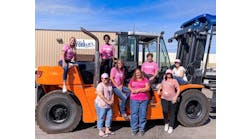Savannah, Ga. — Executives of JCB and local officials broke ground in Savannah, Ga., recently for the JCB Customer Support Center, a 200,000-square-foot service and support center for the company's North American operations. The ground breaking is a symbol of JCB's increased focus on customer support, which is also demonstrated by the appointment of the new vice president of customer support, Mike Werner.
Werner has more than 30 years of experience in the construction equipment industry at companies including International Harvester, JCB and Volvo.
“I saw the return as a tremendous opportunity to be a part of something very significant at JCB,” said Werner. “The company is positioned for growth in this market and the new center marks an important step in that growth process.”
The JCB Customer Support Center will resemble a smaller version of the headquarters for JCB, with its familiar green façade. The headquarters building serves as the North American operations headquarters.
Since JCB is widely credited with building the world's first backhoe, six dignitaries including John Patterson, CEO of JCB World Wide and Graeme Macdonald, president, JCB Inc. broke ground simultaneously by operating backhoe loaders rather than the traditional shovels. The six backhoes used were manufactured at the Savannah facility.
“This is a very significant day for JCB and its North American Operations,” said Patterson. “The JCB Customer Support Center will serve as a global distribution center for North America, South America and the Pacific Rim. But, at the same time, it will stand as visible proof of our commitment to customer support, particularly for our North American customers.”
While the World Parts Center at JCB's world headquarters in the United Kingdom is the main distribution center for JCB parts, the JCB Customer Support Center will serve as the distribution point for parts sourced in the Americas.
Construction of the JCB Customer Support Center should be complete by the fourth quarter of next year. When the new building opens, it will free up about 80,000 square feet of space in the manufacturing facility that will be used to increase the plant's manufacturing capacity.


